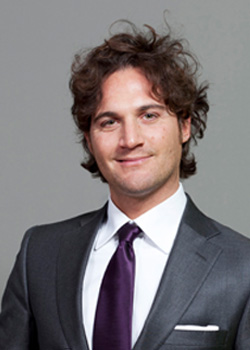Giorgio de Chirico *

(Volos, Greece 1888–1978 Rome)
Piazza d’Italia, late 1940’s, signed; signed, declaration of authenticity and notary inscription (dated 1 April 1963) on the reverse, oil on canvas, 40 x 50 cm, framed
This work is registered in the Fondazione Giorgio e Isa de Chirico under no. 016/06/20 OT and it is accompanied by a photo-certificate of authenticity (dated 22 October 2020).
This work is accompanied by a photo-certificate issued by Claudio Bruni Sakraischik, Rome (dated 23 April 1988).
This work is accompanied by a photo-certificate signed by the artist.
Provenance:
Finarte, Milan, 24 March 1988, lot 54
European Private Collection
Literature:
AA. VV., Arte all’incanto. Aste Finarte 1987/1988, Longanesi & C., Milan 1988, exh. cat. p. 220
De Chirico’s landscapes are silent, solitary, melancholic, immersed in an unreal light and are at times disturbing, they have a powerful dreamlike quality.
One can almost see the silence, it is a silence that fascinates and, at the same time, disturbs the absolute motionlessness of the image, evoking the unreal and the magical. The scenes are well defined, the cooler tones with long, marked shadows filling the squares at the centre where ancient sculptures stand, statues on stone pedestals, which seem to float in the centre of the square, bringing to mind the classicism with which the artist grew up. The shadows are the protagonists, they project themselves onto the whole scene as if they were on stage; in the background, behind a red brick wall, a steam engine appears with a puff of smoke that recalls de Chirico’s journey motif and also his father’s job.
De Chirico searches for every tiny area that eludes the distracted normality of everyday perceptions - he listens to silence, contemplates the invisible, every object is rich in symbolism, and everything is centered around an absence. His landscapes are often solitary, but in some of them it is possible to see those that live in these metaphysical cities: mannequins, dehumanised men, poets, soothsayers, philosophers, archaeologists. In others we find recumbent deities, headless busts and shattered limbs. In his paintings a sense of estrangement dominates and he evokes a suspended and timeless atmosphere. The composition is pure, and free of any added elements.
His cities are true cities of thought, ideal cities in which nothing is as it seems and where a sense of bewilderment is accentuated by a contrast between clarity and darkness. His paintings are ominous, a feeling that is exaggerated by the desolate calm of their isolated urban landscapes, at once familiar and uncanny.
The city is a recurring motif for de Chirico. In his cities, spaces are studded with round, square, cylindrical towers. His cities are timeless, far from the noisy metropolises of the Futurists. The uniqueness of de Chirico’s oeuvre derives from his opposition to all that was the foundation of modern art at the beginning of the twentieth century. At a time when artists tried to change man and move away from figurative painting towards abstraction, de Chirico maintained the codes of traditional painting and focused on reality. Whilst avant-garde movements focused on the dissolution of traditional forms, he defended the painter’s craft, always regarding a painting as a field of vision.
For de Chirico, architecture is geometry and pure materiality, and perspective – despite being rejected by modern art – the foundation of Italian art history.
In this Piazza d’Italia, painted by de Chirico towards the end of the 1940s, there are all the typical elements of the painter’s metaphysical poetics: the square with its architecture and arcades, the statue of Ariadne asleep, the presence of the two men talking to each other, the wall, the tower and the train.
An atmosphere of mystery and expectation pervades the whole space, giving it a powerful solemn silence, enhanced by the long shadow cast by the wall and the tower, the statue and the two men. The arched architectural structure, which in this canvas delimits the two sides of the composition, is for de Chirico the metaphor of the eternal present. It is an element that brings together full and empty, the interior and exterior, light and shadow. Among the architecture, the silent, solitary statue of Ariadne asleep stands out; behind her is the wall, another symbol dear to de Chirico, beyond which we a train and the distant landscape can be discerned. It is just beyond the wall where mystery lies, just out of reach, alongside the train – representing journeys and adventures.
“As I was walking, one hot summer afternoon, through the deserted streets of a provincial town in Italy which was unknown to me, I found myself in a quarter of whose character I could not long remain in doubt. Nothing but painted women were to be seen at the windows of the small houses, and I hastened to leave the narrow street at the next turning. But after having wandered about for a time without enquiring my way, I suddenly found myself back in the same street, where my presence was now beginning to excite attention. I hurried away once more, only to arrive by another détour at the same place yet a third time. Now, however, a feeling overcame me which I can only describe as uncanny.”
S. Freud, The Uncanny, 1919
Esperto: Alessandro Rizzi
 Alessandro Rizzi
Alessandro Rizzi
+39-02-303 52 41
alessandro.rizzi@dorotheum.it
24.11.2020 - 16:00
- Prezzo realizzato: **
-
EUR 271.700,-
- Stima:
-
EUR 140.000,- a EUR 180.000,-
Giorgio de Chirico *
(Volos, Greece 1888–1978 Rome)
Piazza d’Italia, late 1940’s, signed; signed, declaration of authenticity and notary inscription (dated 1 April 1963) on the reverse, oil on canvas, 40 x 50 cm, framed
This work is registered in the Fondazione Giorgio e Isa de Chirico under no. 016/06/20 OT and it is accompanied by a photo-certificate of authenticity (dated 22 October 2020).
This work is accompanied by a photo-certificate issued by Claudio Bruni Sakraischik, Rome (dated 23 April 1988).
This work is accompanied by a photo-certificate signed by the artist.
Provenance:
Finarte, Milan, 24 March 1988, lot 54
European Private Collection
Literature:
AA. VV., Arte all’incanto. Aste Finarte 1987/1988, Longanesi & C., Milan 1988, exh. cat. p. 220
De Chirico’s landscapes are silent, solitary, melancholic, immersed in an unreal light and are at times disturbing, they have a powerful dreamlike quality.
One can almost see the silence, it is a silence that fascinates and, at the same time, disturbs the absolute motionlessness of the image, evoking the unreal and the magical. The scenes are well defined, the cooler tones with long, marked shadows filling the squares at the centre where ancient sculptures stand, statues on stone pedestals, which seem to float in the centre of the square, bringing to mind the classicism with which the artist grew up. The shadows are the protagonists, they project themselves onto the whole scene as if they were on stage; in the background, behind a red brick wall, a steam engine appears with a puff of smoke that recalls de Chirico’s journey motif and also his father’s job.
De Chirico searches for every tiny area that eludes the distracted normality of everyday perceptions - he listens to silence, contemplates the invisible, every object is rich in symbolism, and everything is centered around an absence. His landscapes are often solitary, but in some of them it is possible to see those that live in these metaphysical cities: mannequins, dehumanised men, poets, soothsayers, philosophers, archaeologists. In others we find recumbent deities, headless busts and shattered limbs. In his paintings a sense of estrangement dominates and he evokes a suspended and timeless atmosphere. The composition is pure, and free of any added elements.
His cities are true cities of thought, ideal cities in which nothing is as it seems and where a sense of bewilderment is accentuated by a contrast between clarity and darkness. His paintings are ominous, a feeling that is exaggerated by the desolate calm of their isolated urban landscapes, at once familiar and uncanny.
The city is a recurring motif for de Chirico. In his cities, spaces are studded with round, square, cylindrical towers. His cities are timeless, far from the noisy metropolises of the Futurists. The uniqueness of de Chirico’s oeuvre derives from his opposition to all that was the foundation of modern art at the beginning of the twentieth century. At a time when artists tried to change man and move away from figurative painting towards abstraction, de Chirico maintained the codes of traditional painting and focused on reality. Whilst avant-garde movements focused on the dissolution of traditional forms, he defended the painter’s craft, always regarding a painting as a field of vision.
For de Chirico, architecture is geometry and pure materiality, and perspective – despite being rejected by modern art – the foundation of Italian art history.
In this Piazza d’Italia, painted by de Chirico towards the end of the 1940s, there are all the typical elements of the painter’s metaphysical poetics: the square with its architecture and arcades, the statue of Ariadne asleep, the presence of the two men talking to each other, the wall, the tower and the train.
An atmosphere of mystery and expectation pervades the whole space, giving it a powerful solemn silence, enhanced by the long shadow cast by the wall and the tower, the statue and the two men. The arched architectural structure, which in this canvas delimits the two sides of the composition, is for de Chirico the metaphor of the eternal present. It is an element that brings together full and empty, the interior and exterior, light and shadow. Among the architecture, the silent, solitary statue of Ariadne asleep stands out; behind her is the wall, another symbol dear to de Chirico, beyond which we a train and the distant landscape can be discerned. It is just beyond the wall where mystery lies, just out of reach, alongside the train – representing journeys and adventures.
“As I was walking, one hot summer afternoon, through the deserted streets of a provincial town in Italy which was unknown to me, I found myself in a quarter of whose character I could not long remain in doubt. Nothing but painted women were to be seen at the windows of the small houses, and I hastened to leave the narrow street at the next turning. But after having wandered about for a time without enquiring my way, I suddenly found myself back in the same street, where my presence was now beginning to excite attention. I hurried away once more, only to arrive by another détour at the same place yet a third time. Now, however, a feeling overcame me which I can only describe as uncanny.”
S. Freud, The Uncanny, 1919
Esperto: Alessandro Rizzi
 Alessandro Rizzi
Alessandro Rizzi
+39-02-303 52 41
alessandro.rizzi@dorotheum.it
|
Hotline dell'acquirente
lun-ven: 10.00 - 17.00
kundendienst@dorotheum.at +43 1 515 60 200 |
| Asta: | Arte moderna |
| Tipo d'asta: | Asta in sala con Live Bidding |
| Data: | 24.11.2020 - 16:00 |
| Luogo dell'asta: | Wien | Palais Dorotheum |
| Esposizione: | online |
** Prezzo d'acquisto comprensivo di tassa di vendita e IVA
Non è più possibile effettuare un ordine di acquisto su Internet. L'asta è in preparazione o è già stata eseguita.
